“I think it looks terrific,” says David Hockney. “It’s all on one theme, isn’t it? And there’s not many exhibitions like that, really, a show all about the spring.”
The 83-year-old artist is taking a look around his new exhibition at the Royal Academy in London for the first time. He seems happy with it – and rightly so, for it is hypnotic and ravishing. But while I am getting a sneak preview in person, Hockney is here only virtually, his face appearing on two screens, one a giant TV, the other on a small laptop.
He is at home, at what he calls his “seven dwarves house” in Normandy, in northern France, wearing a red, black and white check jacket, a checkerboard tie, a blue-green pullover and round, gold-framed glasses. His kaleidoscopic choice of clothing, challenging the limits of the video call’s bandwidth, is as vibrant and beguiling as the canvases hanging around us. Hockney has not just painted spring; he has come dressed as it.
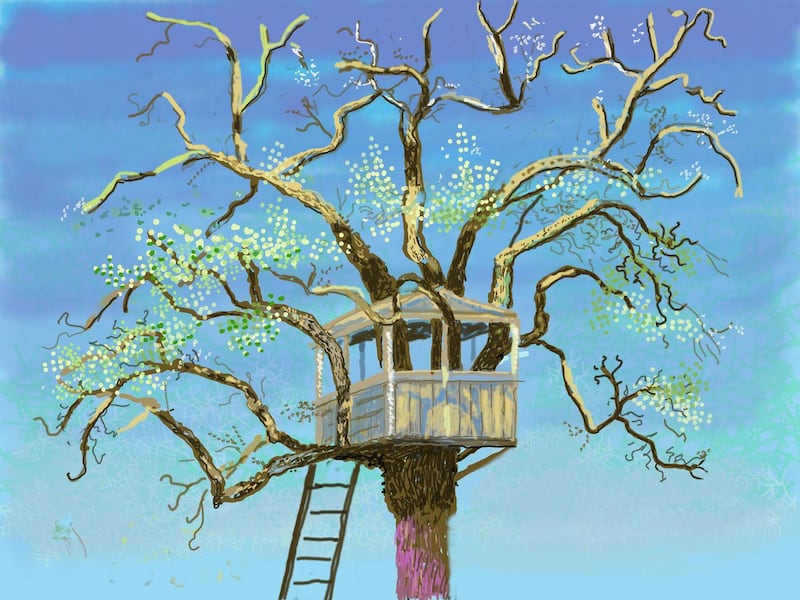
The artist has agreed to talk me through the exhibition, called The Arrival of Spring, Normandy, 2020, and the arrangement underlines his idiosyncratic ease with technology. To make these iPad paintings, he and his team created a version of the Brushes app, working with a computer expert in Leeds to speed things up. "Drawing requires a certain speed," Hockney says. "In Rembrandt's drawings, you can see how fast he drew."
I can't handle Hockney on the big screen, so I sit in front of the laptop – after first taking in his art. He has filled some of the grandest rooms in the Royal Academy with pictures of blossoming branches, spilling flowerbeds, a rain-spattered pond and a tree house: simple subjects, faithfully depicted. I first saw many of these last spring, in my email inbox. Day after day, sometimes more than once a day, I would find a new Hockney, fresh from France, which was a great pick-me-up as the full scope of the pandemic began to dawn.
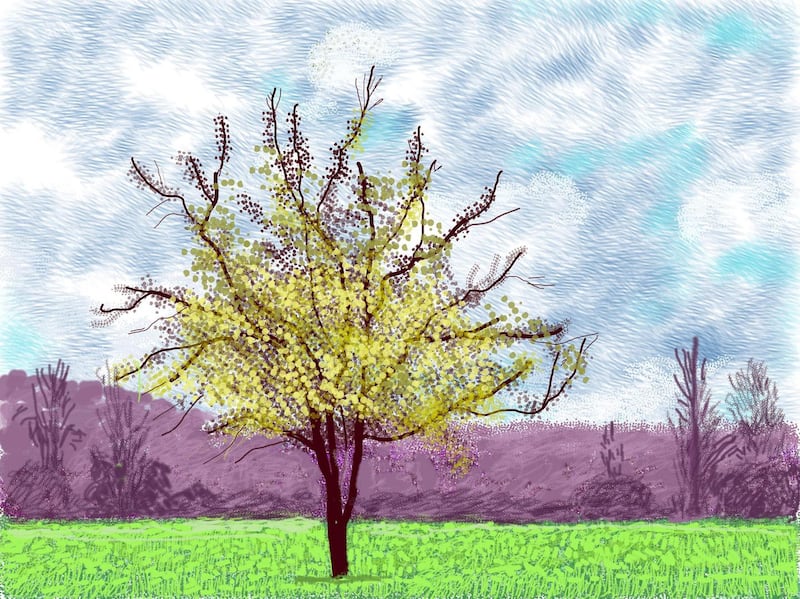
The trouble was that I was soon running out of superlatives in my replies. He was “doing the arrival of spring in Normandy”, as he puts it, and the work made headlines around the world when he released a few images to the media. Clearly, it was not just me who found Hockney’s passionate pictures of new life in his cottage and garden in the Norman paysage uplifting. Here was movingly optimistic art, full of the promise of spring, even as Covid plunged the planet into despair.
Now those pictures have been printed up to the scale of oil landscapes and are looking even better. This is Hockney's best exhibition in a long time, perhaps his most important ever, given the ode to joy it offers an injured world. It is also "a homage", he says, to the painters who first inspired him. Hockney was born in industrial Bradford in 1937 and grew up in a smoggy postwar Britain. Where did he get a feeling for all the bright, strong colours that sweep this exhibition?
“Well, it came from Monet and Matisse and Picasso. Bradford was a very, very black city then. The buildings were totally black from coal. And that’s what I painted: you couldn’t see colour much. But I do remember going to a Van Gogh show in Manchester in 1954. I thought Van Gogh was quite a rich artist, because he could use two whole tubes of blue to paint the sky. I’ve always remembered that exhibition. It was a marvellous thing for me to see.”
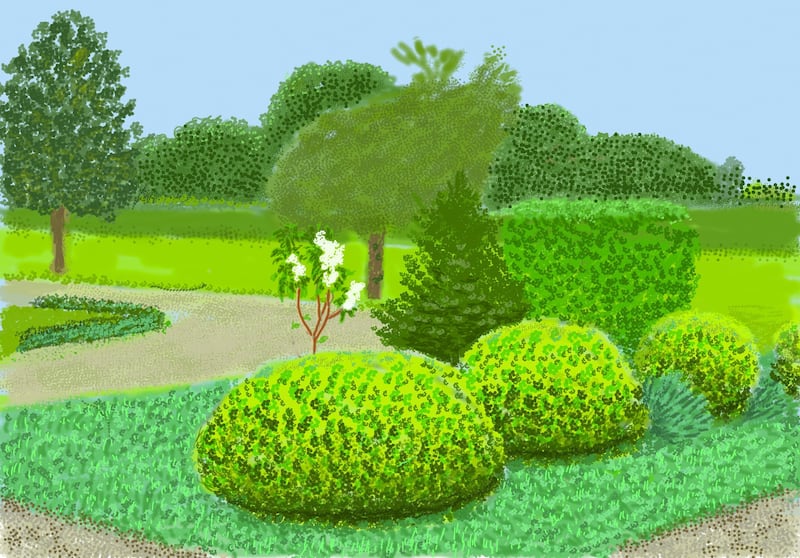
That reminds him about Van Gogh's turbulent personality. "There's a story – I think this is true – that Van Gogh was always bothering Toulouse-Lautrec to start a commune for artists. Well, Lautrec was an aristocrat painting in Paris, and he wasn't interested in communes at all. He said to Van Gogh, 'You should go to Arles.' He wanted to be rid of him." Hockney is laughing. "I'm sure that's true, because he'd be annoying him. Well, he did go to Arles, and it was good, wasn't it?"
Hockney’s life can be seen as one long quest for brighter sunshine, stronger colours, sharper light. He always wanted to be an artist: when he got into grammar school in Bradford, he found it was only the bottom class that was allowed to “waste time” on drawing, so he deliberately failed every subject. He left his soot-black birthplace for art college in London, then went on a trip to New York, where he bleached his hair and realised postwar London was drab compared with the United States.
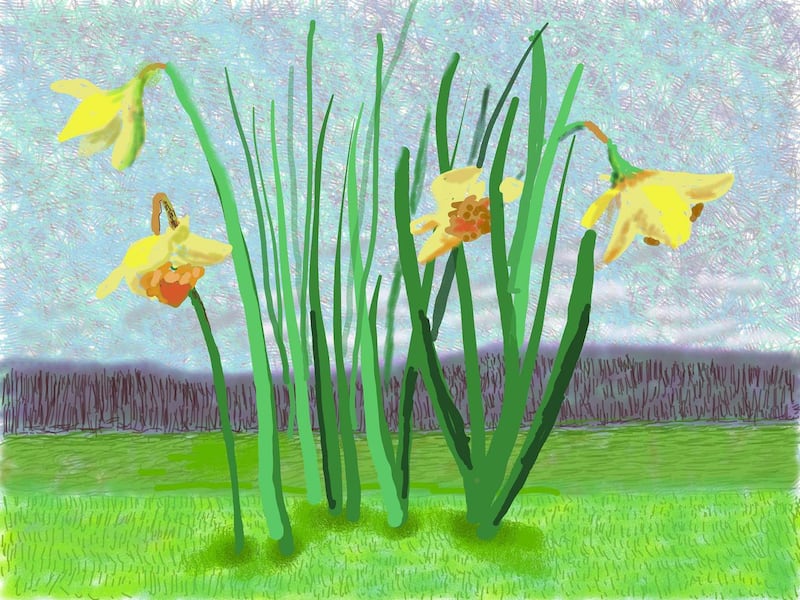
By 1964, he was living in Los Angeles. The way he feels about Normandy now is the way he felt about California then. "I remember in Bradford there weren't many shadows, because the light was just grey light, mostly. I'd noticed the shadows in Hollywood movies, and I knew Hollywood was a bright place with sun, so I wanted to go there. Like Van Gogh going to Arles."
Hockney is a hedonist painter. His pictures are about enjoyment. His pursuit of life, liberty and happiness first expressed itself in unabashed portrayals of gay desire, at a time when homosexuality was a crime in Britain. But his paintings of his Los Angeles friends, such as the writer Christopher Isherwood, of swimming pools and swimmers, of men in showers, are not just records of his life; they are poetic rhapsodies of colour and light. It is through the white spume of a diver's splash, against dark-blue water under a light blue sky, that he expresses longing, love, the moment held. "California has a very clear light. You can see 100 miles sometimes. It's very, very clear, and that's what I loved about it."
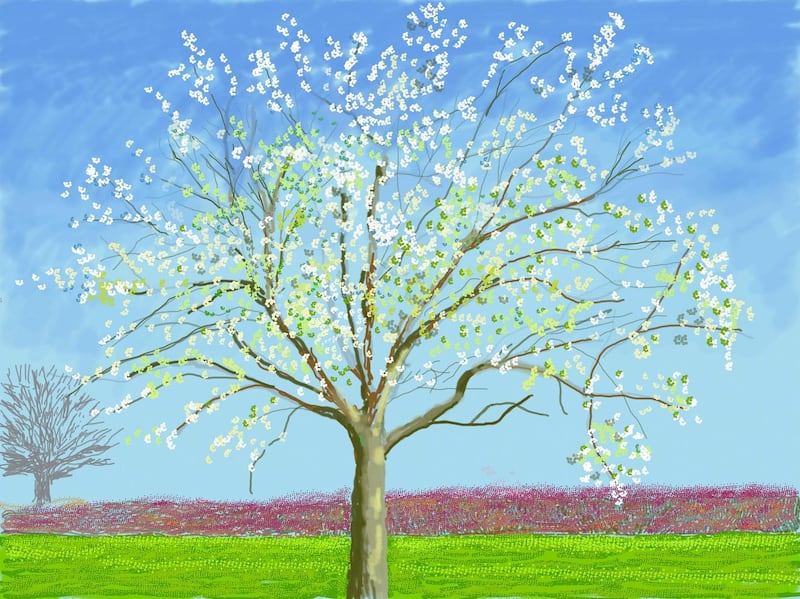
On November 15th, 2018, at Christie's in New York, one of the greatest of Hockney's early works – his sensual and mysterious 1972 masterpiece Portrait of an Artist (Pool with Two Figures) – set a world record for a living artist at auction when it fetched $90 million. But Hockney had other things on his mind then. He had found what he calls his "paradise". Not the glamorous paradise he once saw in Hollywood but the pastoral paradise of a French garden.
He had driven through Normandy and was struck by the countryside. “It’s very, very beautiful, this part of the world. It’s unbelievably green. Everywhere we look is green. The horizons are just all trees: the only buildings we can see from the house are my studio or the barn. Otherwise, it’s just trees. We can’t see, quite, the sunset, because there’s some hills in the way. The sunrise I can watch from the kitchen window. Just as it’s coming up, a little gold bar comes over the horizon. It’s quite magic: you can only look at it for about two minutes, three minutes, then it’s too bright. I can see it in the winter from my bedroom, because then it’s moved south. It will move north until June 21st; then it will start its journey south again.”
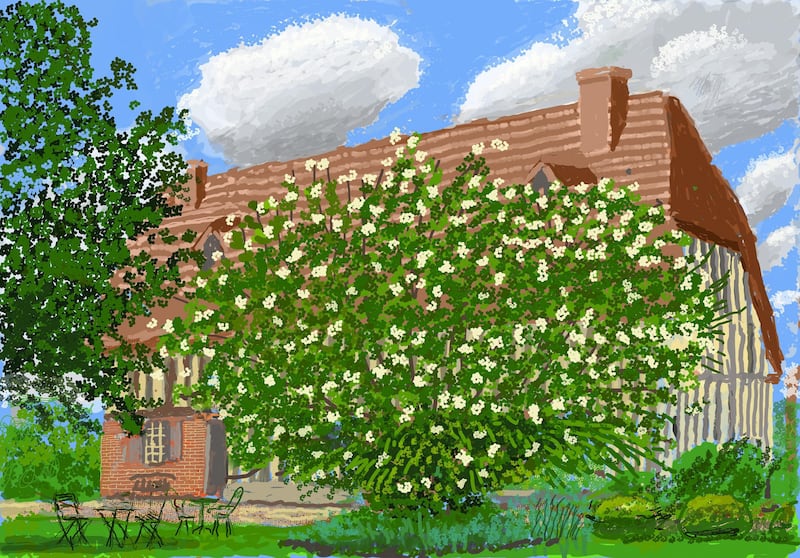
He said he had thought about finding a place to paint spring in this lush region, discussing the project with his assistant, Jean-Pierre Gonçalves de Lima. “J-P said, ‘Well, if you rent a house, you might not be able to smoke in it.’ So he rang up some agents. From the moment we entered this place, we both fell in love with it. We were only here about 25 minutes and decided to get it, because it wasn’t that much money. In Sussex, it would have cost a hell of a lot more.”
Hockney seems to think his impulse purchase needs to be justified. His groundedness, like his accent, is one of the ways in which he has never left Yorkshire. But there is nothing modest about the project on which he has embarked. “I’m teaching the French how to paint Normandy. They gave up painting, didn’t they? That’s Derrida, isn’t it? When he said painting was dead, I always thought that was wrong, because I thought, Well, that means the only depiction taken seriously is a photograph. Everybody’s a photographer now, aren’t they? Drawing is far more interesting.” He gestures around the gallery. “If these were photographs, they wouldn’t look anywhere near as good, I don’t think. At all!”
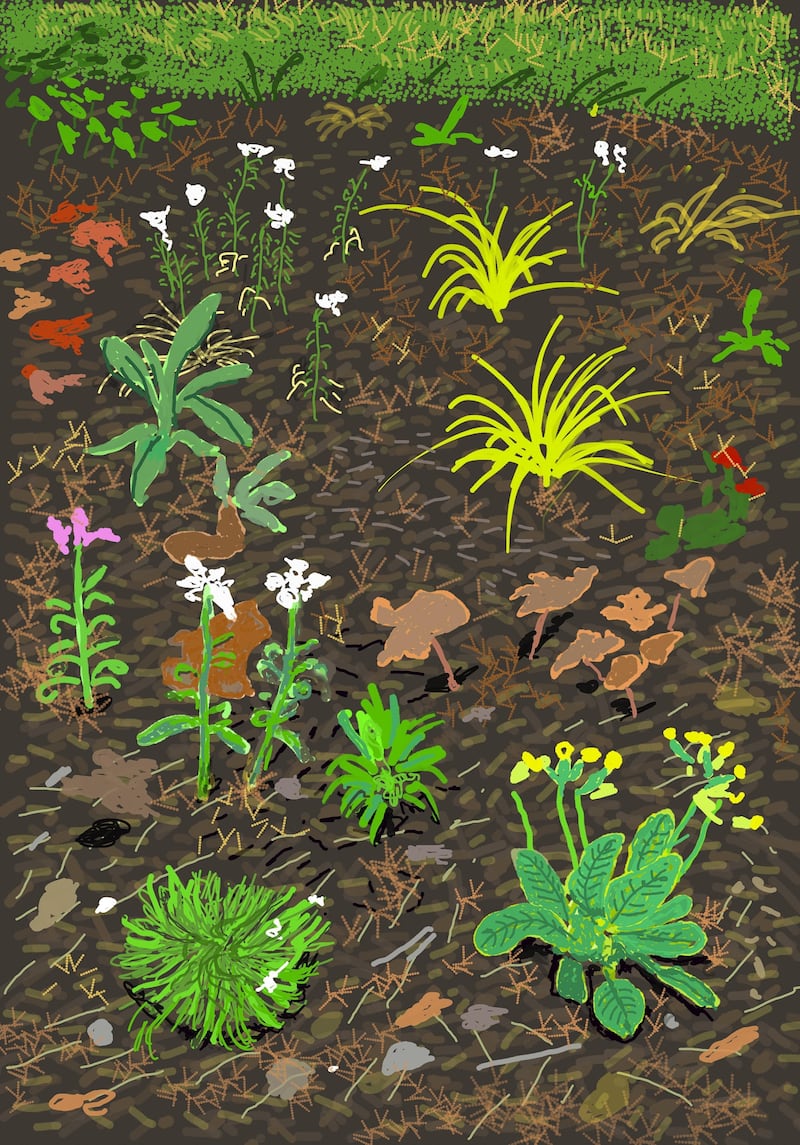
The great "tradition" of modern French painting has, he thinks, been allowed to die: there is no equivalent, in the country, of the painters who have kept the flame alive in Germany, Britain and the US. So here is a Yorkshireman, in his cap, to teach France how to see itself afresh – and the lesson seems to be going down well. "Some French company has named a rose after me," he says, beaming.
The Arrival of Spring was shown in Paris last year, and Hockney is preparing for a major show at the Orangerie, one of the French capital’s great museums. There, he will join together his Normandy pictures to create a modern Bayeux tapestry 88m long. The show will also put him alongside the most symphonic of all French landscape painters, Monet, as the gallery is home to Monet’s Nymphéas, his expansive, enfolding paintings of the lily pond at his garden in Giverny, in Normandy.
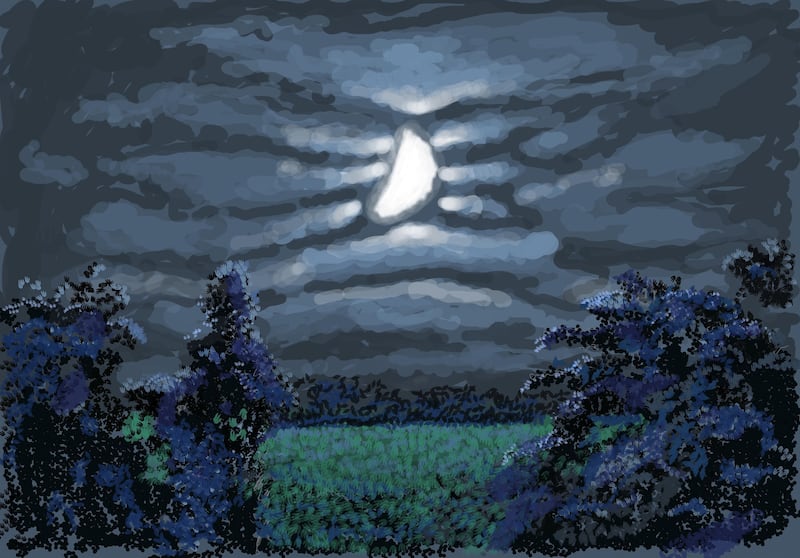
“Aww, he’s a great, great, great painter,” says Hockney when I wonder why Monet is often misunderstood as a “chocolate box” artist. “Monet saw 40 springs, 40 summers, 40 autumns and 40 winters in Giverny. They’re fantastic paintings. They’re still very, very fresh, aren’t they? They could have been painted yesterday. It was horticultural, mostly flowers, because he lived in a walled garden.
“Have you been to Giverny? The lake where he had the nymphéas, you had to cross a railway to get to it. He had a little bridge. He would look at it and probably smoke two cigarettes and then walk back to his studio and paint it. The walk was three minutes, really. You can have a very, very strong visual memory for an hour or so after you’ve been looking at something intensely, and that’s what he did. I don’t care if they’re on chocolate boxes!”
Like Monet, Hockney is creating a personal world of natural beauty to paint. His garden covers 1.6 hectares, or 4ac, and has a stream at the bottom. Walking around the Royal Academy exhibition, you feel as if you are there, strolling around, entranced. There are even a couple of lilies in a pond, which Hockney has depicted full of reflections, like Monet’s. What does he think is the appeal? “I think it’s space: the trees exist in space. How do we see space? Sometimes people say, ‘Well, we only see objects, we don’t see space.’ But we feel space, don’t we? I think that’s absolutely true. I feel it here.”
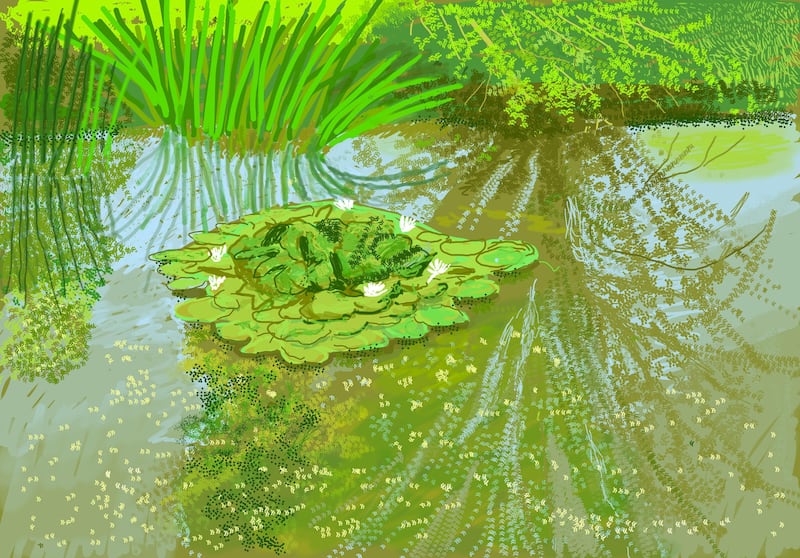
Gonçalves de Lima is shaping his garden just as Monet shaped his: “When I was doing The Arrival of Spring in 2020, J-P was planning for 2021. He was already planning new flowerbeds, placing trees in different places. We’ve got a pine tree now, with cords holding it up. They will stay there for a while, then it won’t blow down. He sees that I draw in layers and he arranges trees, flowers and things accordingly.”
Monet gave the paintings that hang in the Orangerie to the French state after the tragedy of the first World War. A century on, Hockney has shown again that painting nature is a resonant response to a great crisis. But today he is not in the mood to be mawkish about the pandemic. Instead, he jokes that Gonçalves de Lima calls these pictures “the Covid collection”, as if they were in a fashion show. And, far from suffering, he insists he had the time of his life in lockdown. At last, it gave him total peace to work. “I had a wonderful time,” he says. “I worked long hours. I’d go to bed at nine o’clock sometimes – and sometimes it was still light when I went to bed. But I loved getting up early in the morning, like Monet did.”
In California, he adds, there isn't really a spring because there isn't really a winter. It was only when he started spending more time in Britain that he noticed the season again. "The first spring I'd seen in 20 years was in 2002," he says. "I was sitting for Lucian Freud and I walked every morning through Holland Park. I noticed the spring and I thought, Oh, it's very exciting, this. Very exciting." – Guardian
David Hockney: The Arrival of Spring, Normandy, 2020 is at the Royal Academy in London from May 23rd until September 26th, 2021. Spring Cannot Be Cancelled: David Hockney in Normandy, by Martin Gayford and David Hockney, is published by Thames & Hudson











